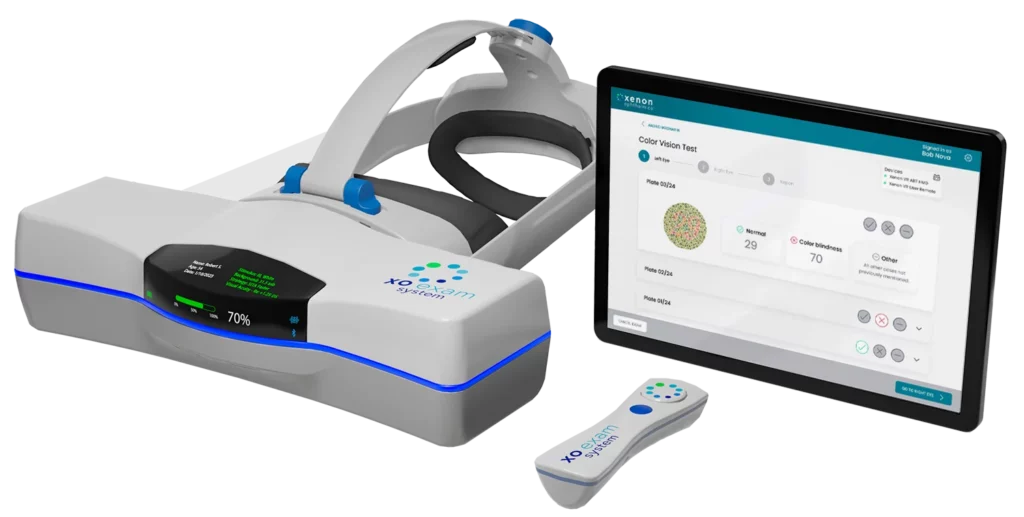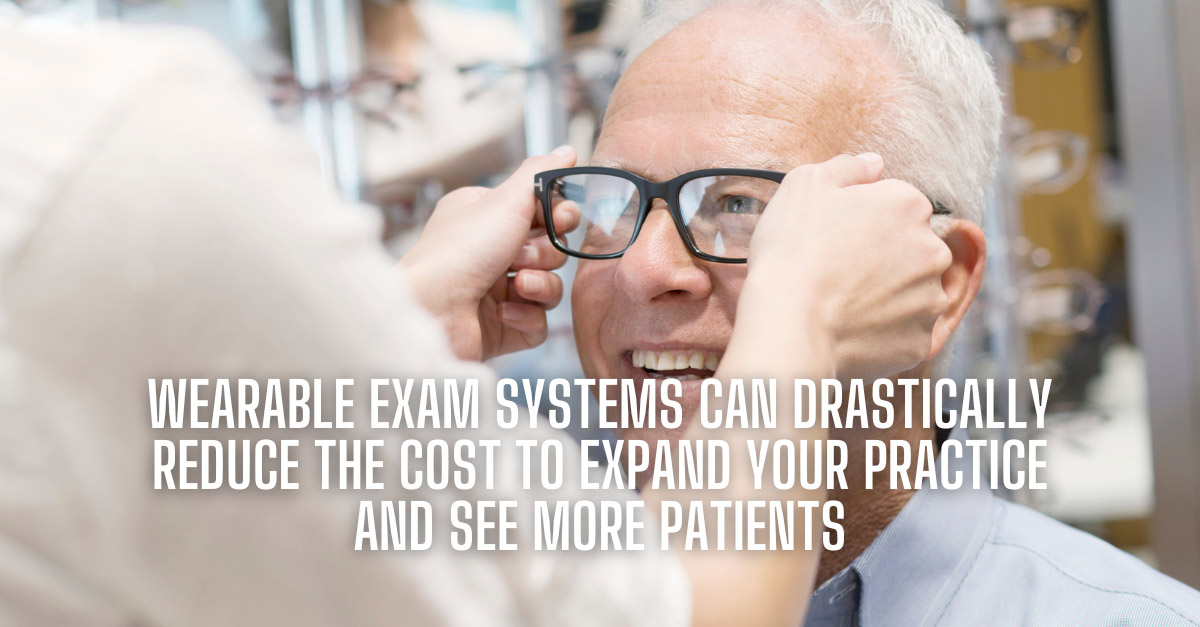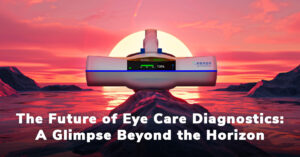The Optical Industry has seen significant advancements in technology in recent years. One area that has shown promise is wearable ophthalmic diagnostic systems, which have the potential to revolutionize the way eye examinations are conducted with their portable form factor and high accuracy.
These new technologies offer a paradigm shift in the patient experience, with greater access, comfort, and convenience. They can also greatly improve the Optometric practitioner’s delivery of care.
With the global demand for eye examinations on the rise due to the prevalence of myopia, an aging populus, and other eye-related diseases and conditions, Optometrists and other specialty Optometrists, are under pressure to see more patients.
Wearable ophthalmic diagnostic systems can help them meet this challenge, see more patients, and improve care.
Demand for Vision Care is a Growing Problem Around the World
According to recent World Economic Forum findings, “Uncorrected poor vision is the world’s most widespread disability. Although 75% of all blindness and visual impairment is treatable, there is a lack of access to eye care in many societies. To meet global health goals, the world needs 14 million optometrists.” However, expanding a typical Optometric practice to meet this demand can take time and effort.
Wearable ophthalmic diagnostic systems offer a cost-effective solution to this problem by enabling Optometrists to see more patients without investing in expensive equipment or hiring and training additional staff.
Expanding Your Practice to See More Patients Yet Maintain a High Level of Care is Costly
Expanding an optometric practice typically involves investing in additional labor, equipment, and office space. Optometrists must purchase various equipment, such as autorefractors, slit lamps, and phoropters, which can cost thousands of dollars each.
In addition, expanding a practice often requires hiring additional staff, such as receptionists, technicians, and opticians, which can also be costly.
These additional costs, which can total thousands of dollars, can make it difficult for Optometrists to expand their practice, particularly those in rural or low-income areas where patient demand may be high, but financial resources may be limited. Wearable ophthalmic diagnostic systems offer a cost-effective solution to these challenges.
Wearable headsets, for example, are portable and non-invasive devices that patients can wear to conduct various eye tests with the help of a minimally trained technician, or even in a self-service kiosk-type environment.
The devices are typically connected to a tablet or computer, which enables Optometrists to administer the exams, often remotely, and view the results of the tests in real time.
>The portability of these devices means that Optometrists can conduct eye examinations in a broader range of locations, such as schools, community centers, and more, making it easier to reach more patients.
New advancements in wearable ophthalmic diagnostic headset technology, such as Xenon Ophthalmic’s XO Exam™ System, have enabled Optometrists to conduct remote eye examinations. These headsets are equipped with cameras, microphones, language translation, and sensors to capture high-quality images and data from patients’ eyes.
The data is then transmitted in real-time within the same practitioner office, or to a remote location, where the Optometrist can view it on a proprietary tablet and conduct the examination. This technology enables Optometrists to provide high-level vision care with as many as ten patients at a time, significantly increasing efficiency and reducing costs.
The ability to conduct remote eye examinations with wearable ophthalmic diagnostic headsets has significant potential to increase the efficiency of Optometric practices.
With the ability to see multiple patients at once, Optometrists can reduce wait times for patients and see more patients overall, leading to higher patient throughput and increased revenue for the practice.
In addition, remote examinations can benefit patients who live in rural or remote areas or have difficulty traveling to a traditional optometry clinic. In an ever increasingly connected world, instruments that digitally connect doctors with patients will be in even greater demand. With wearable ophthalmic diagnostic headsets, these patients can receive high-quality vision care using a telemedicine solution without traveling long distances, saving them time and money.
New Ophthalmic Diagnostic Headset Technology Are an Affordable Alternative for Practice Expansion
One of the crucial advantages of wearable ophthalmic diagnostic systems is their affordability. Wearable headsets, for example, are typically much less costly than traditional equipment and require minimal maintenance. This means that Optometrists can see more patients without investing in expensive equipment or hiring additional staff, thus reducing the overall cost of expanding their practice.
Another advantage of wearable ophthalmic diagnostic systems is that they can provide a wide range of testing options and be updated as new tests become available. Wearable headsets can conduct various eye tests, including visual acuity, contrast sensitivity, color vision, and binocular vision.
With the ability to conduct a wide range of tests, Optometrists can provide comprehensive eye care services to their patients.
Wearable ophthalmic diagnostic systems are also non-invasive, making them more comfortable for patients. Many traditional eye examinations require instruments that touch the eye, such as tonometers or pachymeters, which can be uncomfortable and sometimes painful for patients.
On the other hand, wearable devices can conduct tests without touching the eye, making them more comfortable for patients, especially those who might be nervous or fear eye examinations. Wearable eye exam systems can be especially useful in treating the elderly, the infirm, or the very young.
Several types of wearable ophthalmic diagnostic headsets are available on the market today. Some headsets are equipped with a camera that can capture high-quality images and videos of the eye, while others use sensors to measure various eye functions and movement. Many headsets are also equipped with microphones, which enable Optometrists to communicate with patients during the examination.
Wearable ophthalmic diagnostic headsets have the potential to transform the way eye examinations are conducted, making them more accessible, efficient, and cost-effective.
With the ability to perform remote examinations and see multiple patients simultaneously, Optometrists can expand their reach and provide high-quality eye care services to a broader range of patients.
As technology continues to evolve, wearable ophthalmic diagnostic systems are likely to become even more advanced and widely used in the Optometric profession globally, providing new opportunities for Optometrists to grow their practices while providing quality eye care services to their patients.
Conclusions for Eye Care Professionals
In conclusion, wearable ophthalmic diagnostic systems offer a cost-effective solution for Optometrists looking to expand their practice and help meet the surging global demand for eye examinations.
These systems are portable, non-invasive, and more cost-effective than traditional equipment. They also offer a more comprehensive range of testing options and can be used in a broader range of locations, making them an attractive option for Optometrists looking to expand their reach. By adopting wearable ophthalmic diagnostic systems, Optometrists can reduce the cost of expanding their practice while providing high-quality eye care services to their patients.
The Next-Generation of Medical-Grade Wearable Ophthalmic Diagnostic Technology is Here
Xenon Ophthalmics™is on a mission to transform how eye care is delivered around the globe. Our XO Exam™System of interchangeable, wearable ophthalmic diagnostic units offers next-generation aberrometry (XO Exam™ABT) and visual field (XO Exam™VFT) examinations to increase access to eye care.
Our XO Exam™System is the only medical-grade technology to meet the increasing global demand for eyecare and the eyecare professionals’ ability to meet that demand with the highest level of patient care and practice growth potential.
A Comprehensive Approach to Providing Greater Access to Vision Care While Increasing the Quality of the Care Provided

XO Exam™ System
The XO Exam™ System includes diagnostic features of traditional ophthalmic devices like phoropters, autorefractors, and visual field units.



